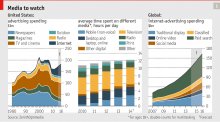 A FEW MONTHS ago Progressive, an insurance company, ran a video ad on Facebook featuring a grown man who acts like a baby and is carried around in a sling. The ad urged youngsters to “act your age” by renouncing their parents’ car insurance and buying their own. When Facebook employees chuckled about it during a meeting, David Fischer, the firm’s 41-year-old head of marketing, wondered why he had never seen it. He was too old, his colleagues said. Progressive was trying to appeal to young drivers, so it served up the ad only to them.
A FEW MONTHS ago Progressive, an insurance company, ran a video ad on Facebook featuring a grown man who acts like a baby and is carried around in a sling. The ad urged youngsters to “act your age” by renouncing their parents’ car insurance and buying their own. When Facebook employees chuckled about it during a meeting, David Fischer, the firm’s 41-year-old head of marketing, wondered why he had never seen it. He was too old, his colleagues said. Progressive was trying to appeal to young drivers, so it served up the ad only to them.
In 1963 David Ogilvy, the father of Madison Avenue and author of a classic business book, “Confessions of an Advertising Man”, wrote: “An advertisement is like a radar sweep, constantly hunting new prospects as they come into the market. Get a good radar, and keep it sweeping.” Half a century later advertisers are at last taking him at his word. Behavioural profiling has gone viral across the internet, enabling firms to reach users with specific messages based on their location, interests, browsing history and demographic group. Ads can now follow users from site to site: a customer who looks online for flights to Frankfurt will be inundated with German holiday offers. Conversant, a digital-marketing firm, uses an algorithm to deliver around 800, 000 variations of an ad to its big clients’ prospective customers to make it as irresistible as possible. Kraft, a food company, monitors online opinions on its brands in an office which it calls “the looking glass”.
Extreme personalisation in advertising has been slow to come, except in search advertising, where Google, Yahoo and other engines have been serving up ads tailored to users’ interests for years. But now it has arrived in earnest. According to one poll by Adobe, a software company, most marketers say they have seen more change in the past two years than in the previous 50.
In the classic advertising model, firms used to place ads with media that brought together the audiences they were after. They would go for business executives in the Wall Street Journal, for example, or youngsters on MTV. But now advertisers no longer have to rely on media as proxies for consumers, because they have more tools and data to target precisely the people they want to reach.









